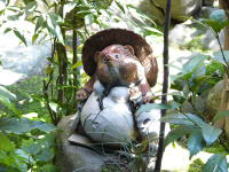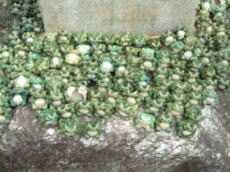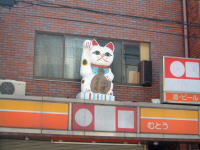| Lucky charm | photo | meaning | |||||
| tanuki (racoon dog) |
 |
Tanuki figurines give us the wisdom to succeed. There are 8 parts of a figurines and each has a special meaning and leads us to success in different ways. 1 hat/ Protects from misfortunes. 2 big eyes/ To take care in all directions and see things in right way. 3 smile / To give anybody a pleasant smile. 4 sake bottle( tokuri)/ Toku means virtue. To be a man of high virtue. 5 book (kayoi-cho)/ Symbol of credit. 6 big belly / Big belly in Japanese is futoppara. Futoppara also means magnanimous. Symbol of calm and brave determination. 7 big scrotum / Testicles are called gold balls and are a symbol of wealth. 8 big tail / The end of the things should be great. |
|||||
| maneki-neko (beckoning cat) |
|
They are holding paws and saying, "come here, come here." It is said that a cat with it's left paw raised (female) calls in people or customers, while a raised right paw (male) calls money or good luck. In the Edo period a prosperity bringing cat actually existed and it became the model for maneki-neko. The story was in 1615. A priest in a declining temple Goutoku-ji loved a cat very much. Though he was very poor, he saved his meal and gave it to the cat. He talked to the cat, "If you would like to repay an obligation, please bring me prosperity." One summer day, the priest noticed that a great samurai was coming to the temple gate. The samurai said that on the way back from falconry he saw a cat beckoning people passing by , so he visited the temple. The priest served him tea and began preaching to him about Buddhism. Suddenly it started to rain heavily. When his preach finished, it also stopped raining. By virtue of the beckoning cat the Samurai was not drenched and so could listen to the preaching The samurai was Naotaka Ii, the feudal lord of Hikone. After that he became a patron of this temple. Then people made a porcelain figure of this cat and it became a good luck charm for prosperity. Maneki-neko is often put at the entrance to old type popular restaurants. |
|||||
| kaeru (frog) |
 |
Kaeru (frog) has the same pronounciation with kaeru (return). Because of this, some people put tiny seramic kaeru in her/his wallet or purse wishing returning of money or wishing for a safe return home |
|||||
| daruma (dharma) |
. |
Daruma is a priest of great renown who founded Zen about 1,500 years ago. The Japanese daruma doll is a charm to bring good fortune and a fortitude to accomplish your goals. Fill in one eye on a daruma doll when you make a goal or wish, and the other when your wish is fulfilled.
|




